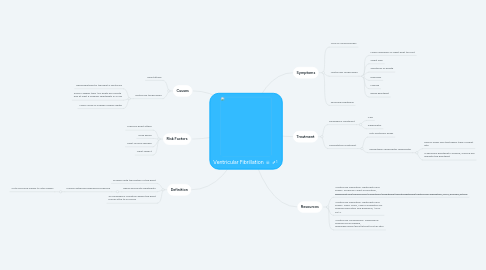Ventricular Fibrillation
by Elizabeth Leigh


1. Causes
1.1. Heart attack
1.2. Ventricular tachycardia
1.2.1. Rapid heartbeat in the heart's ventricles
1.2.2. Pulse is higher than 100 beats per minute and at least 3 irregular heartbeats in a row
1.2.3. Major cause of sudden cardiac death
2. Risk Factors
2.1. Previous heart attack
2.2. Drug abuse
2.3. Heart muscle disease
2.4. Heart defect
3. Definition
3.1. Problem with the rhythm of the heart
3.2. Rapid and erratic heartbeats
3.2.1. Causes extremely high blood pressure
3.2.1.1. Cuts off blood supply to vital organs
3.3. An emergency condition where the heart pumps little to no blood
4. Symptoms
4.1. Loss of consciousness
4.2. Ventricular Tachycardia
4.2.1. Lower chambers of heart beat too fast
4.2.2. Chest pain
4.2.3. Shortness of breath
4.2.4. Dizziness
4.2.5. Nausea
4.2.6. Rapid heartbeat
4.3. Abnormal breathing
5. Treatment
5.1. Emergency Treatment
5.1.1. CPR
5.1.2. Defibrillator
5.2. Preventative Treatment
5.2.1. Anti-arrythmic drugs
5.2.2. Implantable cardioverter defibrillator
5.2.2.1. Device under skin that keeps track of heart rate
5.2.2.2. If abnormal heartbeat is sensed, a shock will regulate the heartbeat

